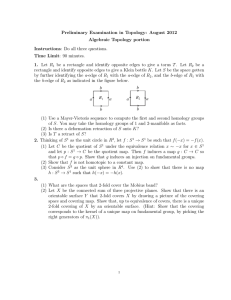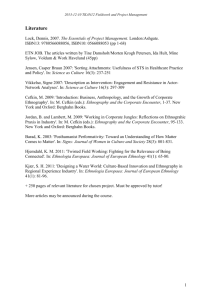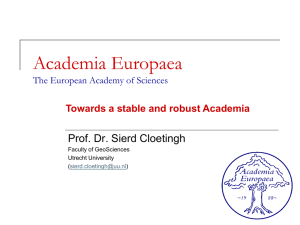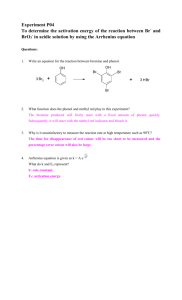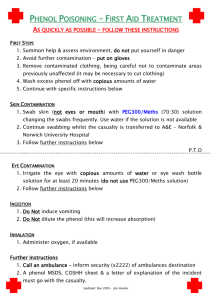Correlation of NE 1545 Expression and Cell Size in Exposed to Aromatic Hydrocarbons
advertisement
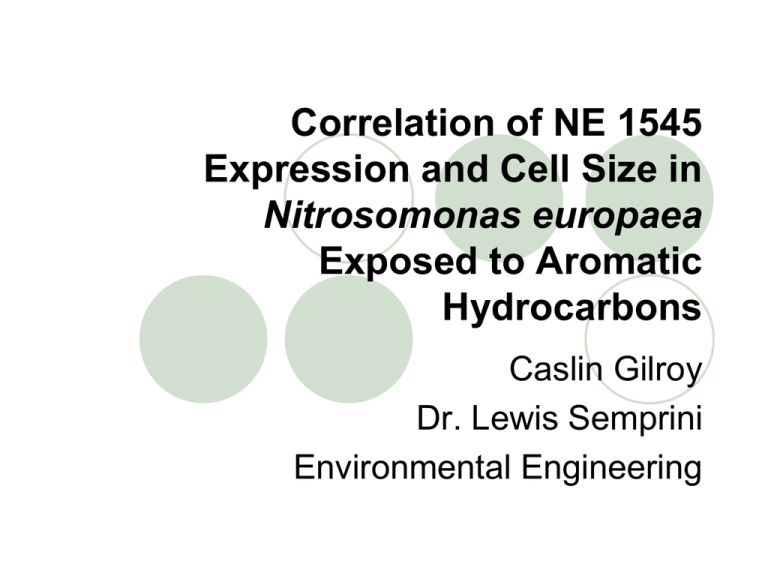
Correlation of NE 1545 Expression and Cell Size in Nitrosomonas europaea Exposed to Aromatic Hydrocarbons Caslin Gilroy Dr. Lewis Semprini Environmental Engineering Wastewater Treatment Plant N. europaea The process of nitrification exhibited by N. europaea is represented by the following reactions: 2H+ + 2e- + NH3 + O2 NH2OH + H2O This step is catalyzed by the enzyme AMO H2O + NH2OH NO2- + 5H+ + 4eThis step is catalyzed by the enzyme HAO Notice that there is a net gain of two electrons, which are used by the bacteria for energy Why is this bacterium important? N. europaea prevents eutrophication in wastewater treatment plants. Causes of Inhibition in Ammonia Oxidation N. europaea is very sensitive to common inhibitors (CN, heavy metals, pH shifts, and organics). Currently can monitor chemical inhibition, but cannot determine cause. Therefore cannot neutralize inhibitors and wastewater treatment plant failure can occur. Solution Want to be able to detect nitrification inhibition AND determine cause of inhibition. Do this by identifying genes expressed in response to specific inhibitors. Create a biosensor to detect N. europaea’s gene expression and link expression to specific chemical contamination. Shift in Cell Membrane Structure A Control B 40 mM Benzene Membrane thickness decreased from 103 + 11 nm to 71 + 4 nm Possible Biosensor Gene Identified NE 1545 linked to cell membrane size and organic compound exposure. Hypotheses: Increased expression of NE 1545 is correlated with exposure to certain aromatic hydrocarbons. Exposure to these hydrocarbons is correlated with a decrease in membrane thickness. Batch Experiments Nitrite Assay 100% 10% 90% 9% 80% 8% 70% 7% 60% 6% 50% 5% 40% 4% 30% 3% 20% 2% 10% 1% 0% 0% 0 10 20 30 40 [Toluene] uM % Activity 50 % Size Decrease 60 70 % Size Decrease % Activity Toluene and Cell Size 100% 10% 90% 9% 80% 8% 70% 7% 60% 6% 50% 5% 40% 4% 30% 3% 20% 2% 10% 1% 0% 0% 0 5 10 15 [Phenol] uM % Activity % Size Decrease 20 25 % Size Decrease % Activity Phenol and Cell Size 100% 10% 90% 9% 80% 8% 70% 7% 60% 6% 50% 5% 40% 4% 30% 3% 20% 2% 10% 1% 0% 0% 0 50 100 150 [Aniline] uM % Activity % Size Decrease 200 250 % Size Decrease % Activity Aniline and Cell Size 100% 10% 90% 9% 80% 8% 70% 7% 60% 6% 50% 5% 40% 4% 30% 3% 20% 2% 10% 1% 0% 0% 0 20 40 60 80 [p-Cresol] uM % Activity 100 % Size Decrease 120 140 % Size Decrease % Activity p-Cresol and Cell Size Compound Dipole pKa Moment Water Log Kow EC50 Solubility Max Size Conc. Change Max NE1545 Change Aniline 2.30D 4.87 387 mM 0.90 55 mM -5% 55 mM 19-fold Phenol 1.70D 9.95 882 mM 1.50 10 mM -6% 22 mM 15-fold p-Cresol 1.50D 10.26 176 mM 1.98 80 mM -5% 60 mM 17-fold m-Cresol 1.45D 10.99 222 mM 1.98 4 mM -2% 8 mM 2-fold o-Cresol 1.45D 10.26 231 mM 1.98 7 mM -2% 8 mM 2-fold Ethylbenzene 0.40D 1 mM 3.15 60 mM -3% 20 mM Toluene 0.36D 28.30 5 mM 2.70 20 mM -1% 63 mM p-Hydoquinone 0.00D 10.35 536 mM 0.60 175 mM -2% 60 mM 2-fold Compound Dipole pKa Moment Water Log Kow EC50 Solubility Max Size Conc. Change Max NE1545 Change Aniline 2.30D 4.87 387 mM 0.90 55 mM -5% 55 mM 19-fold Phenol 1.70D 9.95 882 mM 1.50 10 mM -6% 22 mM 15-fold p-Cresol 1.50D 10.26 176 mM 1.98 80 mM -5% 60 mM 17-fold m-Cresol 1.45D 10.99 222 mM 1.98 4 mM -2% 8 mM 2-fold o-Cresol 1.45D 10.26 231 mM 1.98 7 mM -2% 8 mM 2-fold Ethylbenzene 0.40D 1 mM 3.15 60 mM -3% 20 mM Toluene 0.36D 28.30 5 mM 2.70 20 mM -1% 63 mM p-Hydoquinone 0.00D 10.35 536 mM 0.60 175 mM -2% 60 mM 2-fold Membrane Stability 1 2 3 4 5 6 7 8 Membrane Stability 1 2 3 4 5 6 7 8 9 10 Future Study Continued experimentation with NE 1545 to determine if it is an effective sentinel gene for our biosensor. Acknowledgements Howard Hughes Medical Institute Dr. Lewis Semprini Dr. Tyler Radniecki Dr. Kevin Ahern
